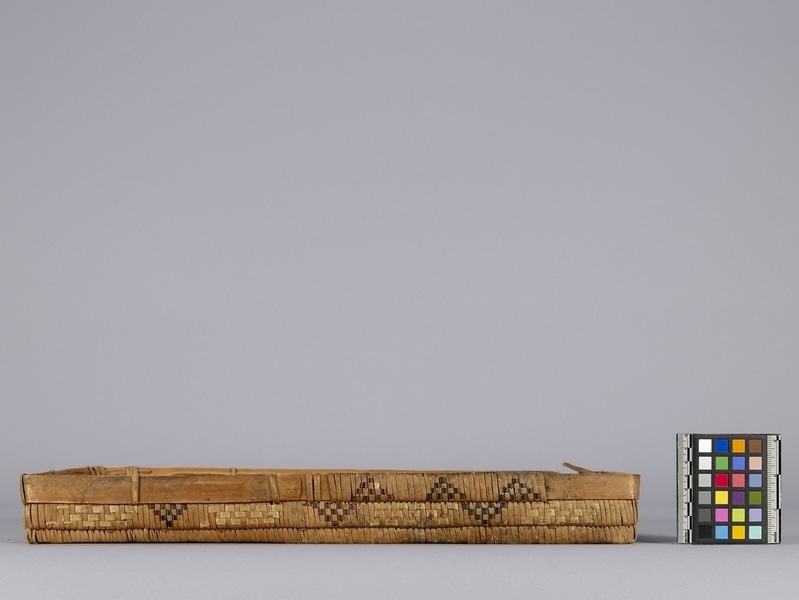Basketry Tray Item Number: A8163 from the MOA: University of British Columbia



Description
Brown basketry tray consisting of interlocking coiled work (unsplit stitches) with parallel slat base and wall construction. Two slat rows form the sides. Decorated with partial beading. One section of decoration remains. It consists of an upper row of black triangles (vertex up) and a lower row of red triangles (vertex down) with five rows of stepped grass.
History Of Use
Coiled basketry traditionally had many uses. It was used for storage of foods, medicines and personal belongings. Some baskets were used for cooking and boiling water, while others had more private uses. Haeberlin and Teit (1928) suggest that in the past not all women were basket makers, but that the skill became more widespread during the early and middle twentieth century when basketry was highly collectible and it became a source of income for many local First Nations women. Basket making declined after the 1950s, but it is still present in many Coast Salish communities and interest is growing.
Narrative
This basket once belonged to Mrs. Bartleman, who lived on the West Saanich Reserve. It may have originated in that community, however the old museum ledger noted it as having a Squamish origin?
Specific Techniques
Sto:lo basket maker Rena Point Bolton noted that the corners on this tray are done in an interesting manner. Roots have been added on the inside surface of the cedar slat to "give it a little bit of thickness, so it wouldn't just be bare wood, "so they would be a little rounded looking."
Item History
- Made in British Columbia, Canada before 1962
- Collected in West Saanich, British Columbia, Canada ? between 1950 and 1962
- Owned by Mrs. Bartleman
- Owned by Edith Bevan Cross before July 30, 1962
- Received from Edith Bevan Cross (Seller) and H. R. MacMillan (Funding source) on July 30, 1962
What
- Name
- Basketry Tray
- Identification Number
- A8163
- Type of Item
- tray
- Material
- cedar wood, grass, cherry bark, cedar root and dye
- Manufacturing Technique
- coiled and imbricated
- Overall
- height 5.7 cm, width 46.4 cm, depth 27.3 cm
Who
- Culture
- Coast Salish
- Previous Owner
- Mrs. Bartleman and Edith Bevan Cross
- Received from
- Edith Bevan Cross (Seller) and H. R. MacMillan (Funding source)
Where
- Holding Institution
- MOA: University of British Columbia
- Made in
- British Columbia, Canada
- Collected in
- West Saanich, British Columbia, Canada ?
When
- Creation Date
- before 1962
- Collection Date
- between 1950 and 1962
- Ownership Date
- before July 30, 1962
- Acquisition Date
- on July 30, 1962
Other
- Item Classes
- basketry
- Condition
- fair
- Accession Number
- 0081/0113 a